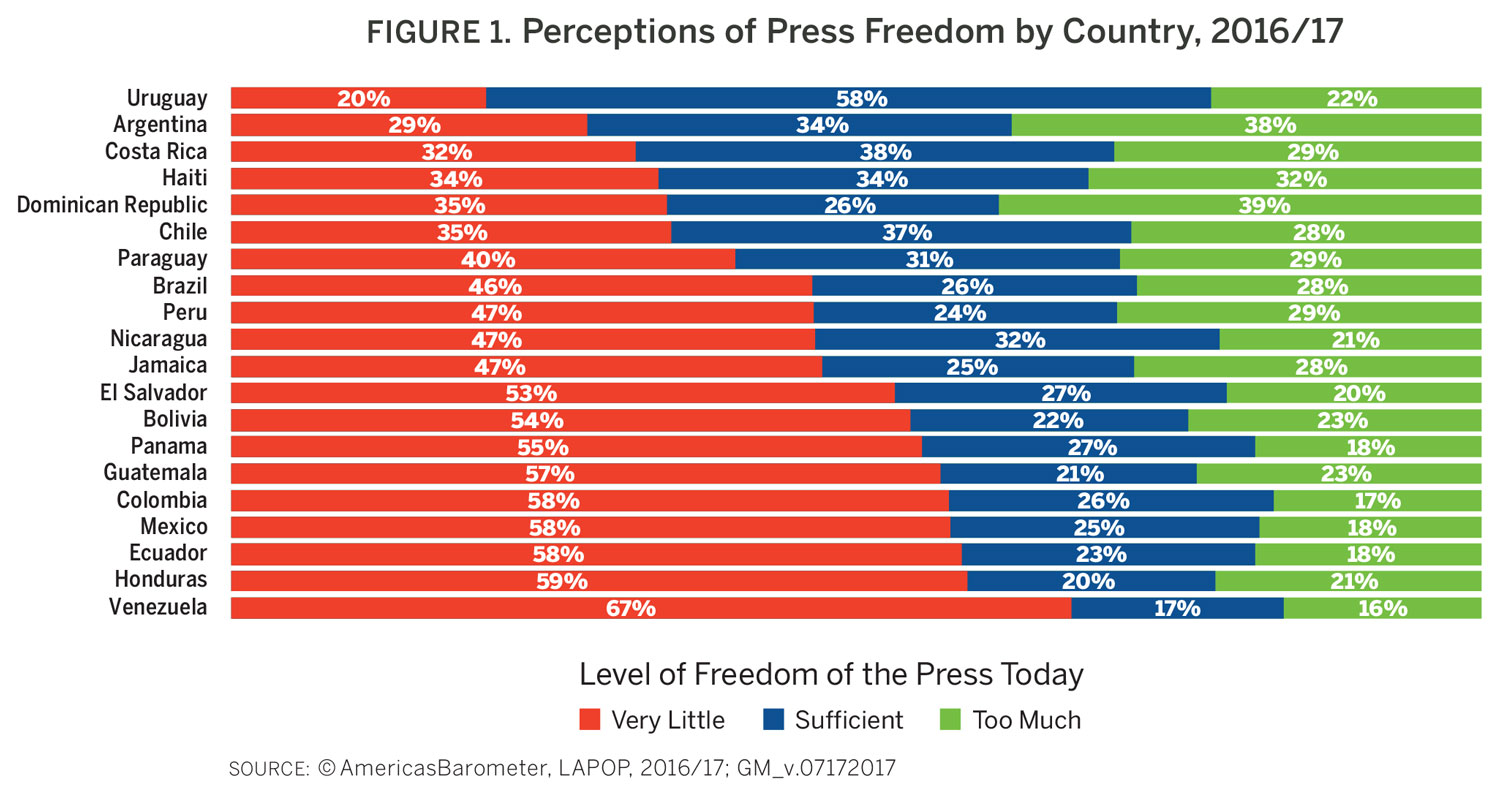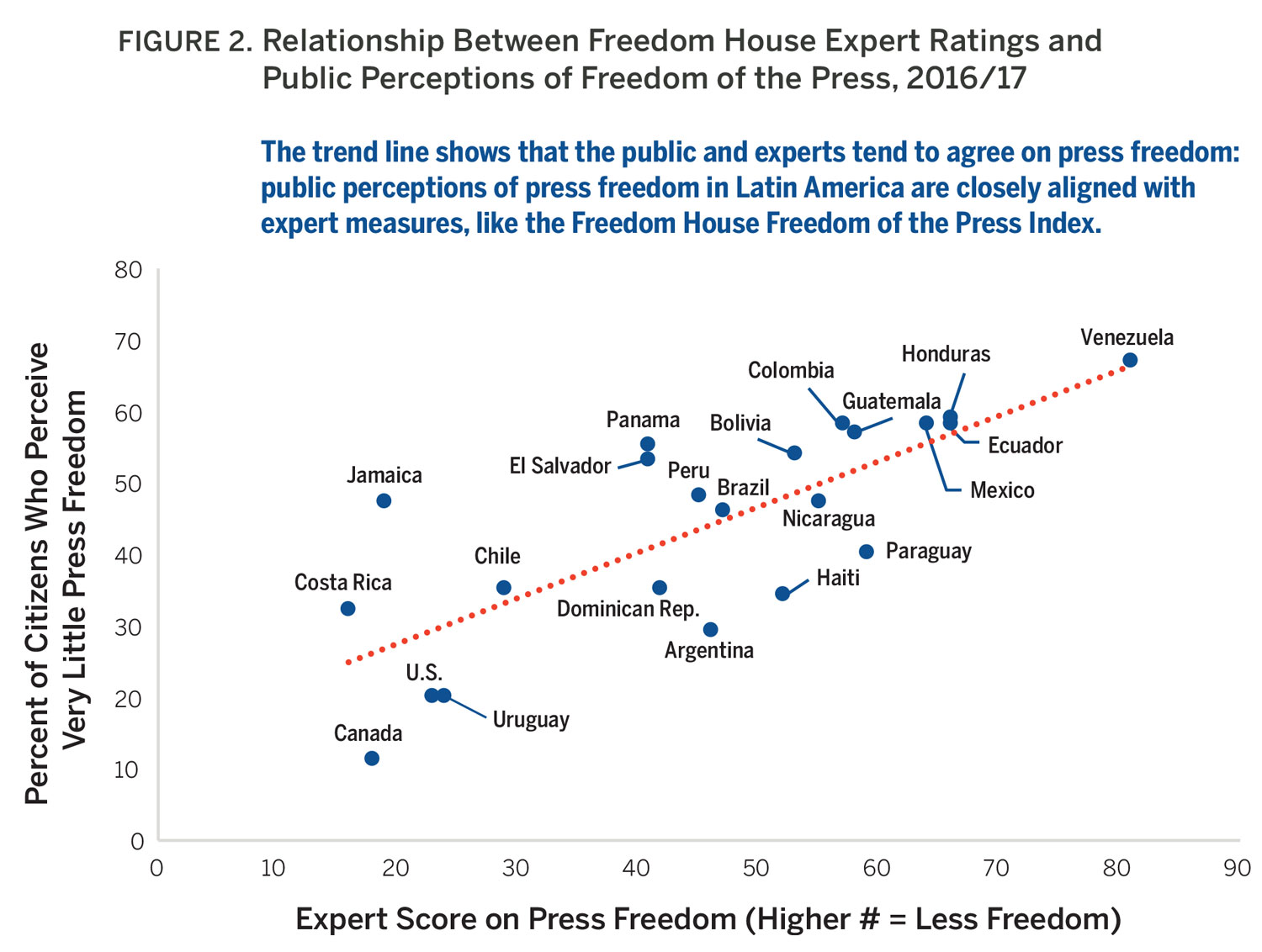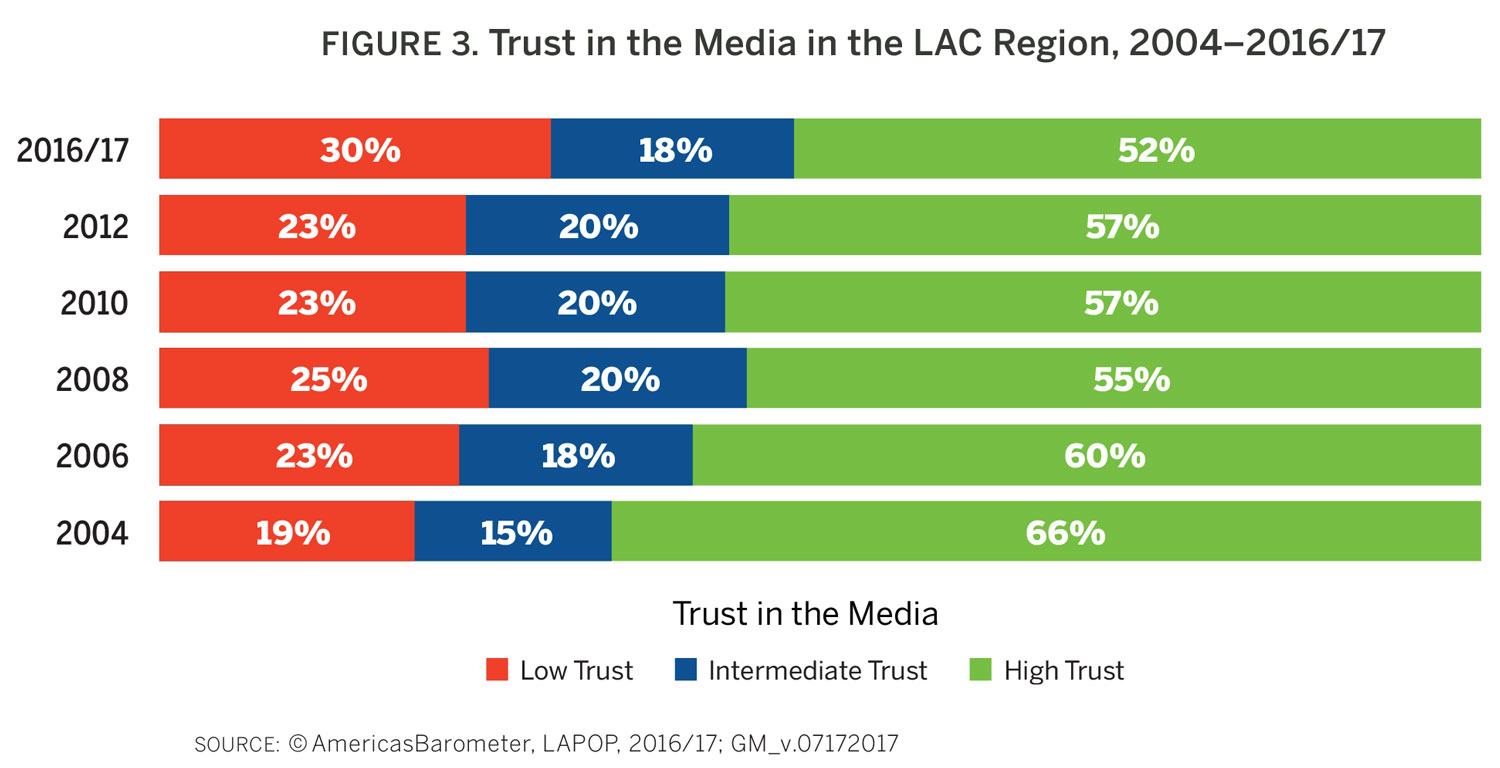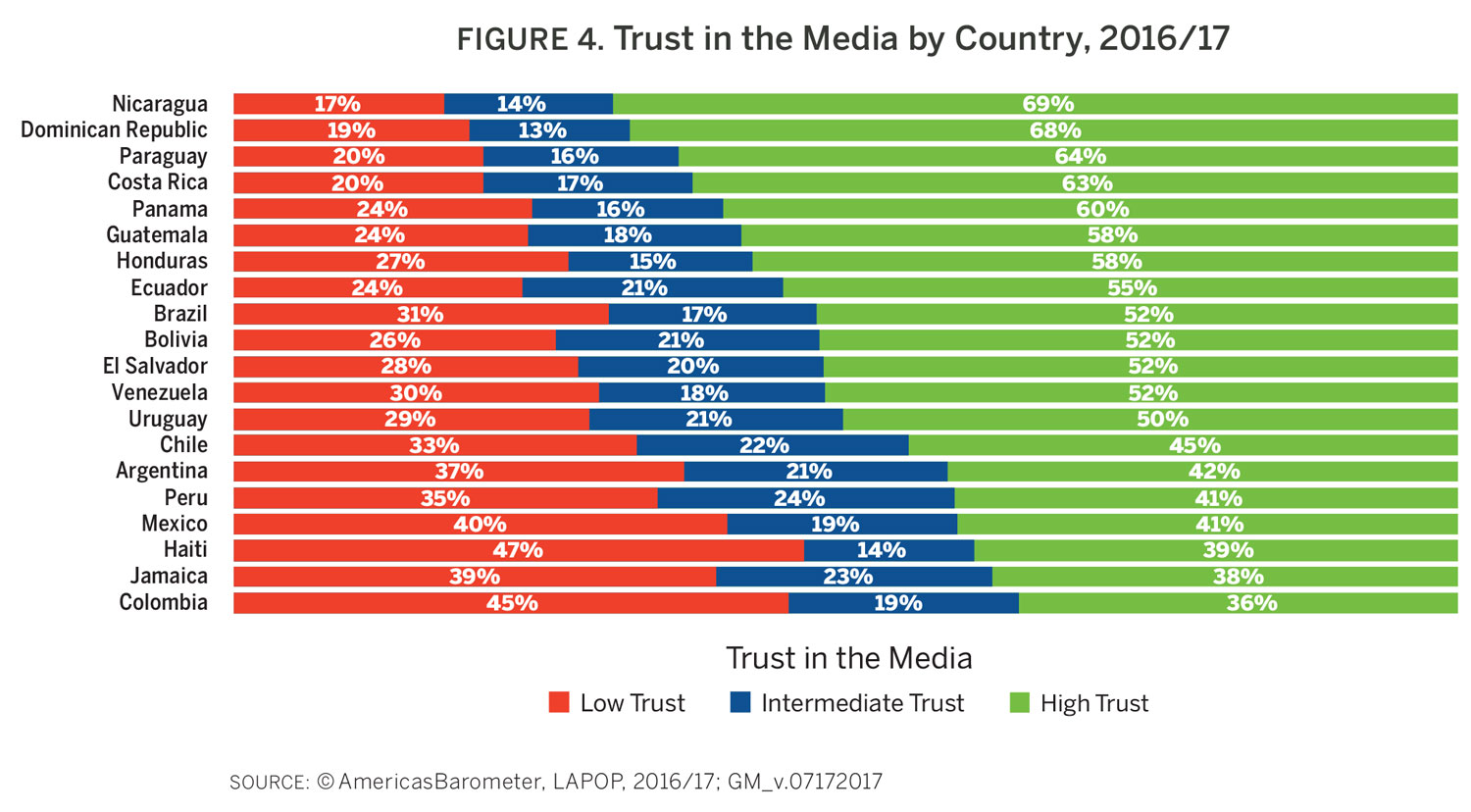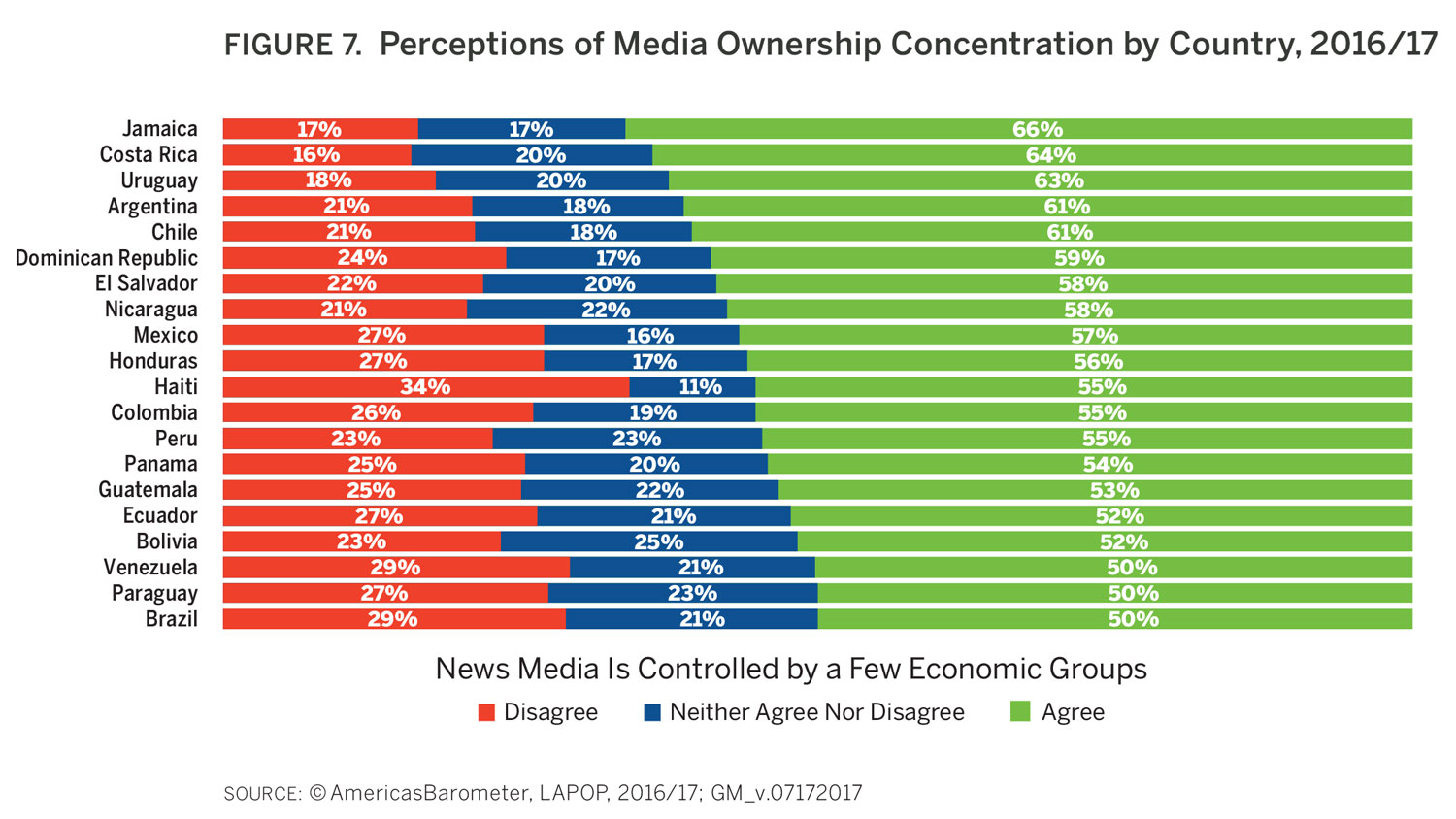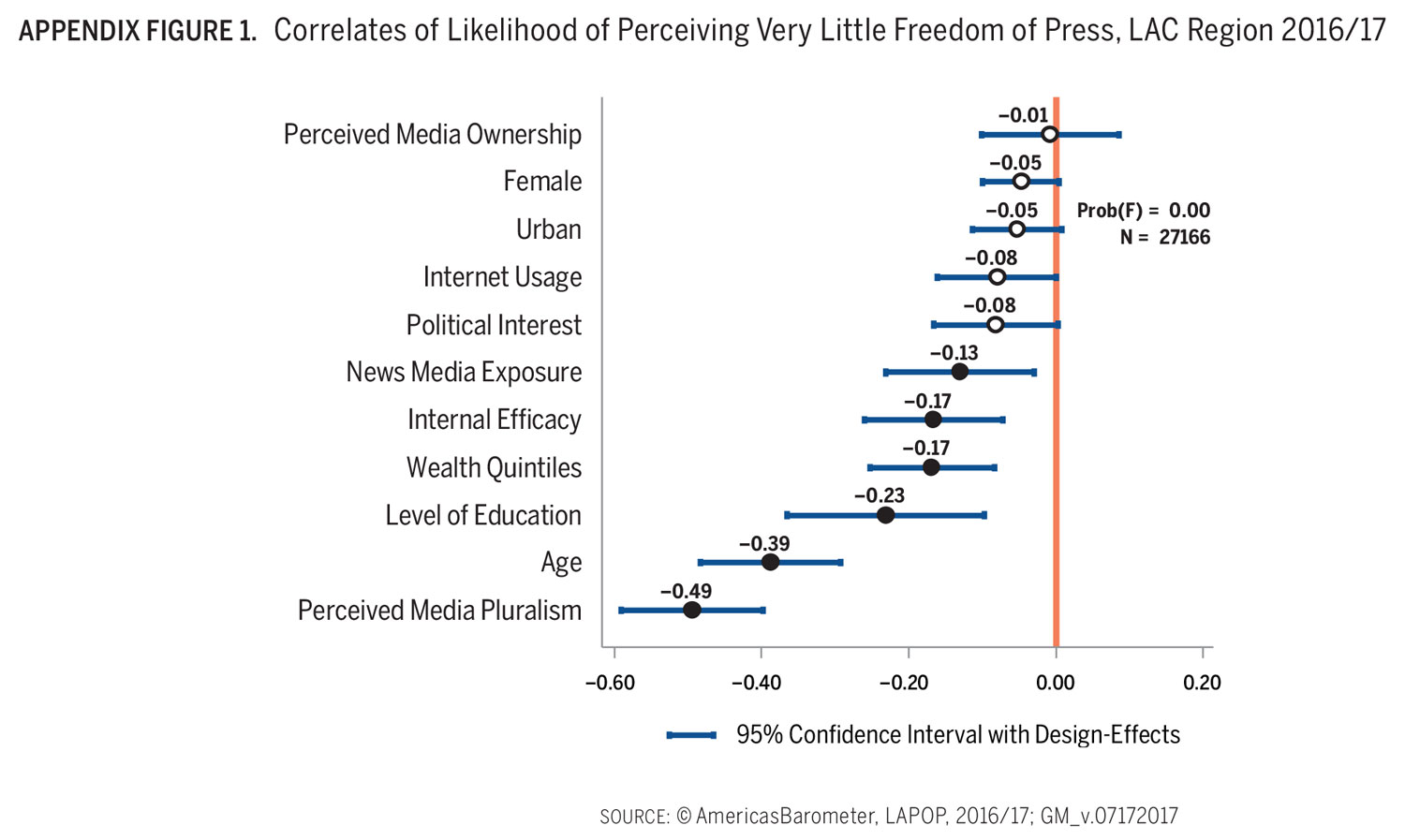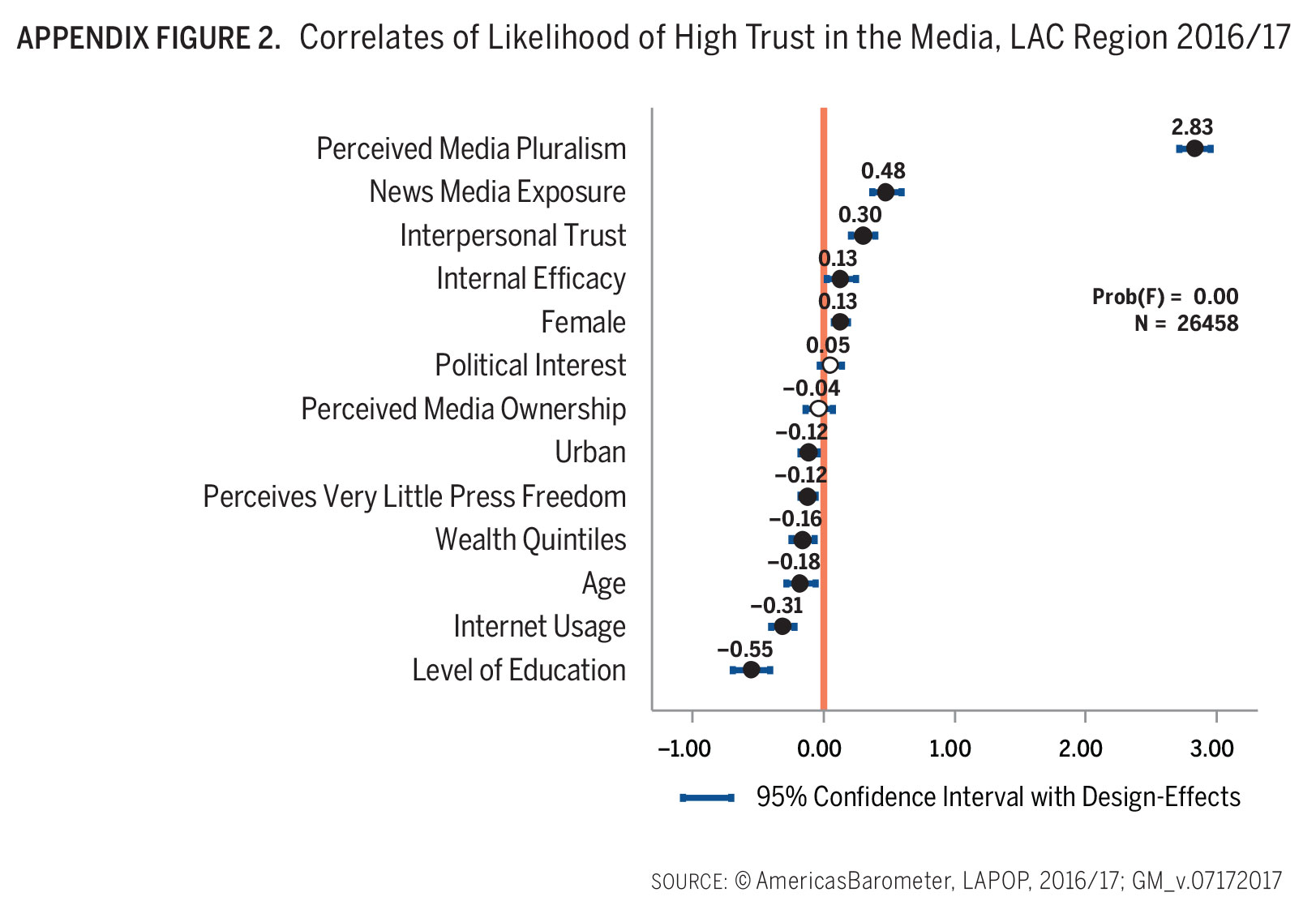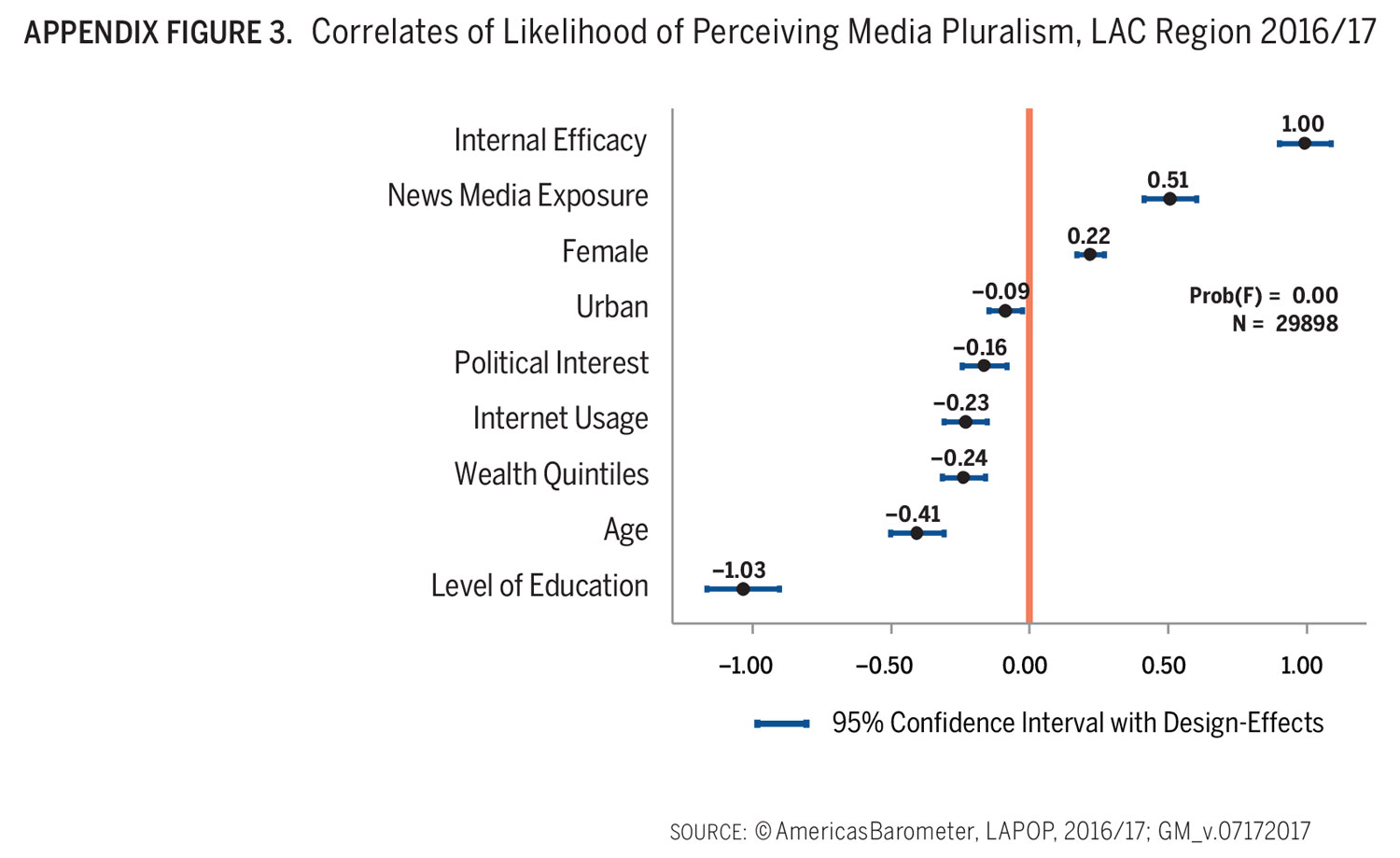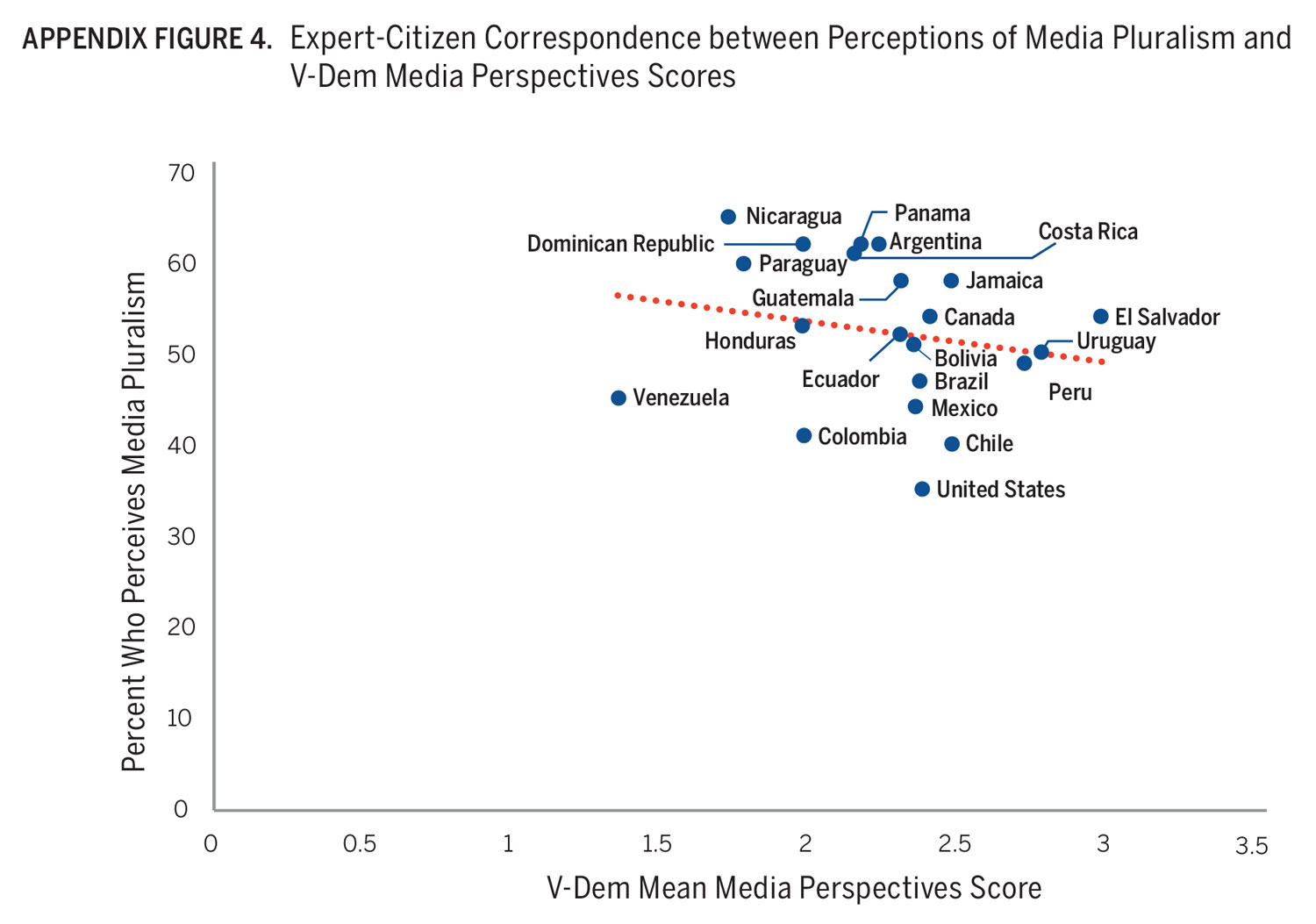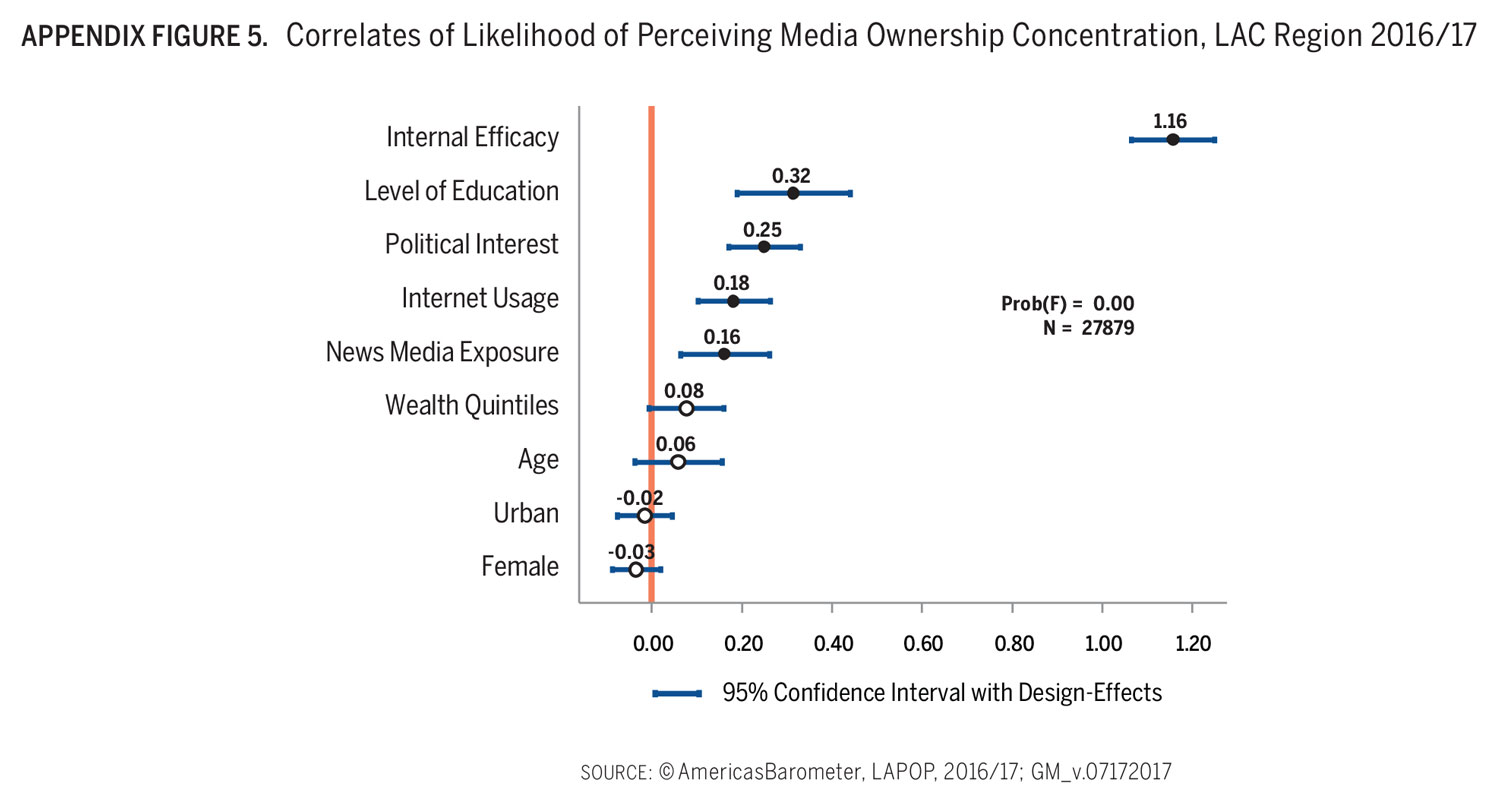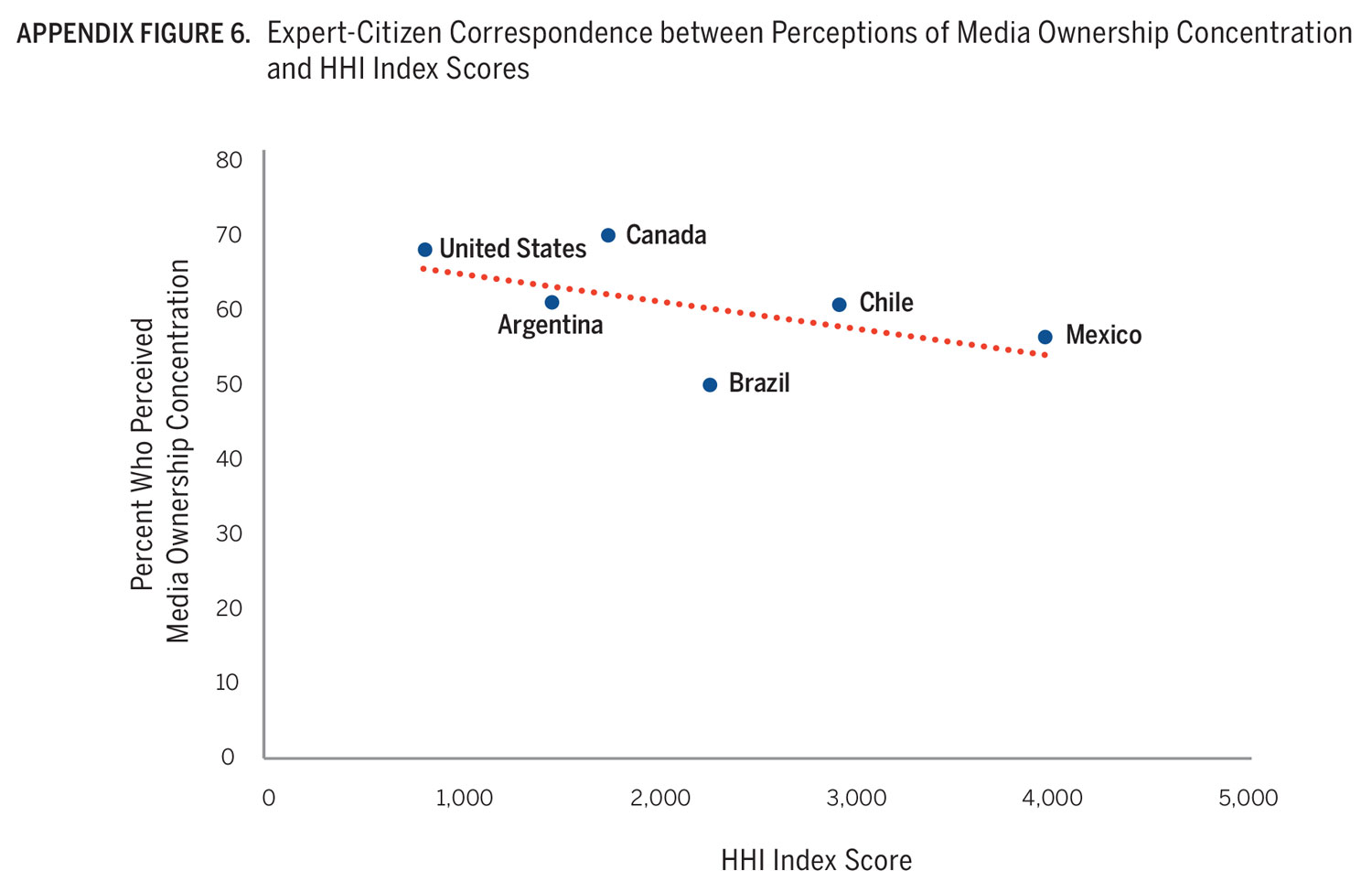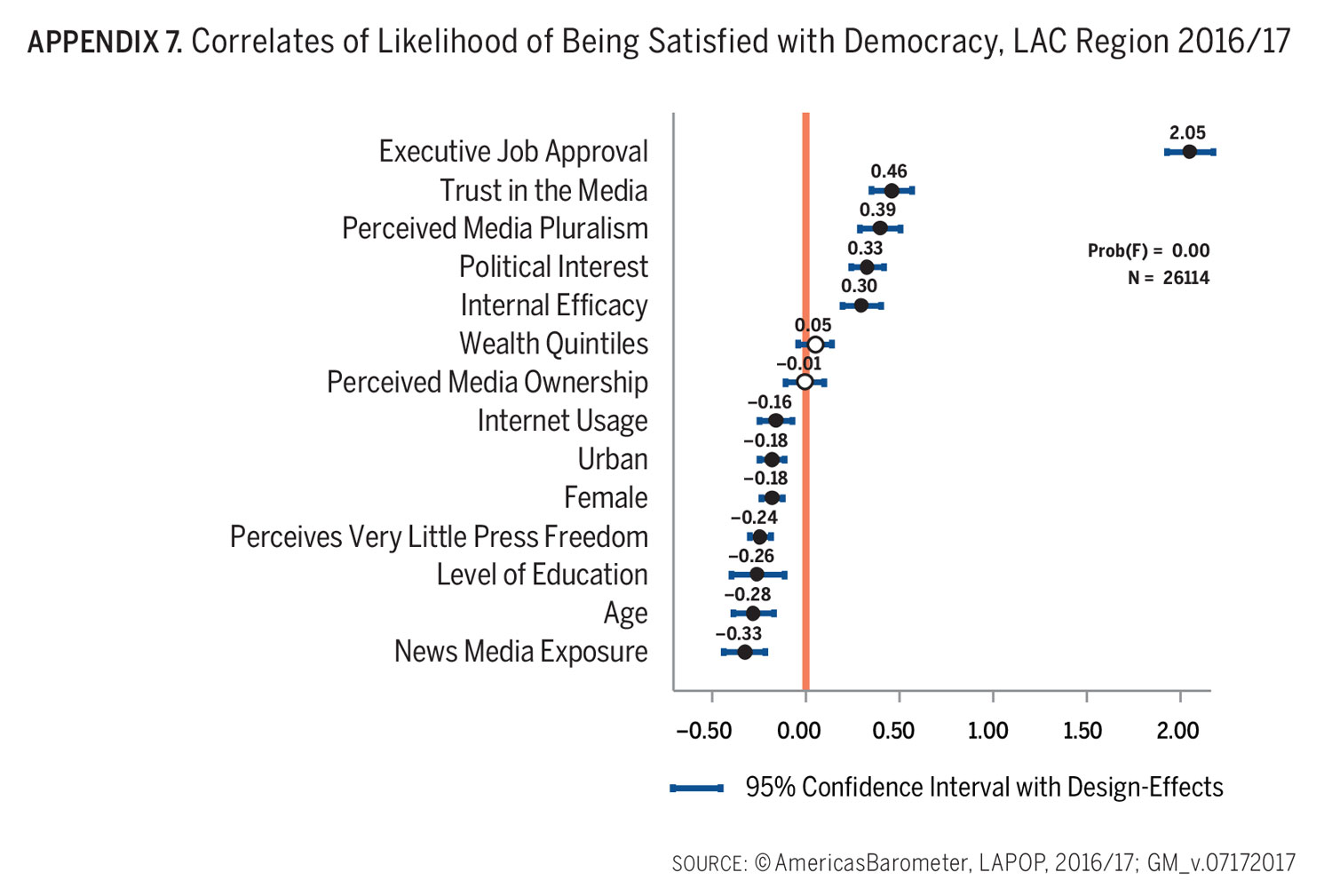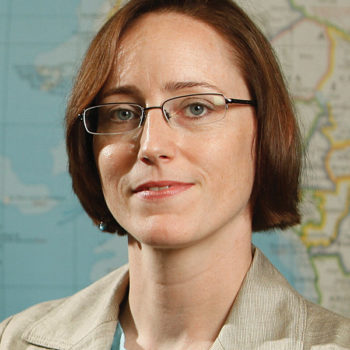Key Findings
As elsewhere, public trust in the media is on the decline in Latin America and the Caribbean. Is this trend attributable to social media? To a broader anti-establishment backlash? Or does it reflect growing concerns over pluralism in the media and the dominant control of the media by a few elites. Understanding the public perceptions on these issues is essential for building broad coalitions for reform. In this report, an analysis of new data from the 2016/2017 AmerciasBarometer survey sheds light on these questions. In addition to surveying the public about press freedom and trust in the media, the latest AmericasBarometer questionnaire also includes five new questions specifically designed to gauge individual perceptions of media pluralism.
• There has been a decline in trust in the media in the LAC region. While in 2004 nearly two-thirds of individuals reported having high trust in the media, this result dropped to only half of individuals in 2016/17.
• Individuals who perceive the media as representative of different viewpoints or who have high trust in the media are more likely to report being satisfied with the way democracy is functioning in their country.
• Citizen evaluations of media pluralism and ownership concentration do not correspond with expert evaluations of media environments in the LAC region. While experts might hold that greater concentration of ownership inevitably erodes pluralism, the public does not make this link.
Introduction: Media and Democracy in Latin America
A context characterized by free, diverse, and independent media is fundamental to democracy. The media not only help citizens form public opinion, but also play a role in the extent to which citizens monitor and react to decisions made by political leaders.1
It is critical to take note, then, that public trust in the media in Latin America and the Caribbean is on the decline. Further, low trust and perceptions of a lack of media diversity are linked to a growing dissatisfaction among citizens with how the region’s democracies are functioning. These are troubling trends that point to the urgent need for media sector reforms to bolster confidence and pluralism. These findings come from analyses of the most recent AmericasBarometer public opinion survey, which has been carried out by the Latin American Public Opinion Project (LAPOP) at Vanderbilt University since 2004 across the Latin American and Caribbean (LAC) region. The survey has long tracked the public’s views about media and democracy, but included for the first time in 2016 and 2017 questions about how citizens in the region view media pluralism and ownership: whether they believe media adequately represent different perspectives and interests in their societies, and whether they see media as controlled by only a few economic actors. What emerges is a more nuanced view of the dynamics undergirding declining faith in media, with important implications for the LAC region’s growing coalition of advocates seeking to democratize the media sphere as a strategy for improving governance.2
In Latin America, the return to democratic forms of governance in the 1980s resulted in significant strides in press freedom. Indeed, Freedom House indicators on press freedom in Latin America reached their peak in 1990, as direct government censorship of the media—prevalent under many Latin American dictatorships— declined significantly. However, some media scholars have criticized the conceptual framework of “press freedom” used to develop these measures for not taking into account another aspect of Latin American media ecosystems that was itself a remnant of the authoritarian period—media ownership concentration.3 The democracy-enhancing role of independent media is hindered when just a few players control media environments. These conditions impede the media’s ability to accurately represent a plurality of social, economic, and political perspectives. Countries in Latin America and the Caribbean face particular challenges in this regard, as they have some of the highest levels of media ownership concentration in the world.
Scholars of Latin American media have characterized the region’s current environment as one of “limited pluralism”—that is, an environment that offers “restricted opportunities for diverse perspectives and issues bounded by commercial priorities, industrial interests, and government designs.”4 Such restrictions pose a serious challenge to efforts to develop and improve the media environment because they inhibit the formation of new media outlets and confine the circulation of high-quality and balanced information. Unsurprisingly, the issue of media concentration has been identified as one of the main challenges to media development in the region, including within discussions at a multistakeholder media consultation in Bogotá, Colombia, in 2015 facilitated by the Center for International Media Assistance and DW Akademie.5
Since the mid-1990s, Latin America has been a laboratory for media reforms. Media movements in a number of countries, notably Argentina and Uruguay, have sought to address the issue of media concentration.6 Research shows that these media reform efforts are most successful when advocates are able to develop broad and diverse coalitions calling for change.7 This finding suggests that, at least to a certain extent, the public’s perception of the issues that face the media environment can impact whether or not media reform efforts are successful.
In representative democracies, citizens transmit concerns and preferences to elected officials. In theory, the prospect of facing the court of public opinion at the polls incentivizes politicians to address public opinion.8 Thus, deficits in the public’s satisfaction with the media environment constitute, or can be channeled into, demand for reform.
Yet little prior research has examined how the mass public perceives the media across the LAC region. In particular, public opinion surveys have not sought to capture how citizens in Latin America and the Caribbean perceive levels of media pluralism and concentration and how this might affect the broader media environment and democratic governance more generally.
To truly understand the prospects for reforms that could boost media development efforts, more data are needed about how the public perceives the media environment and how those perceptions relate to their satisfaction with democracy. In other words, answers are needed the following questions:
■ Do individuals perceive there to be significant restrictions on freedom of the press?
■ To what extent does the mass public perceive there to be pluralism in media content and ownership?
■ How do opinions about the media relate to satisfaction with democracy?
This report provides answers to these questions via the analysis of an original dataset collected from 20 countries in the Western Hemisphere by LAPOP’s 2016/17 AmericasBarometer survey. In the following sections we unpack the most relevant findings as they pertain to media development efforts in Latin America and the Caribbean. While some of the results are indicative of an increasingly constrained and precarious media environment, they also offer insights into how media stakeholders can target their interventions to foster development and reform.
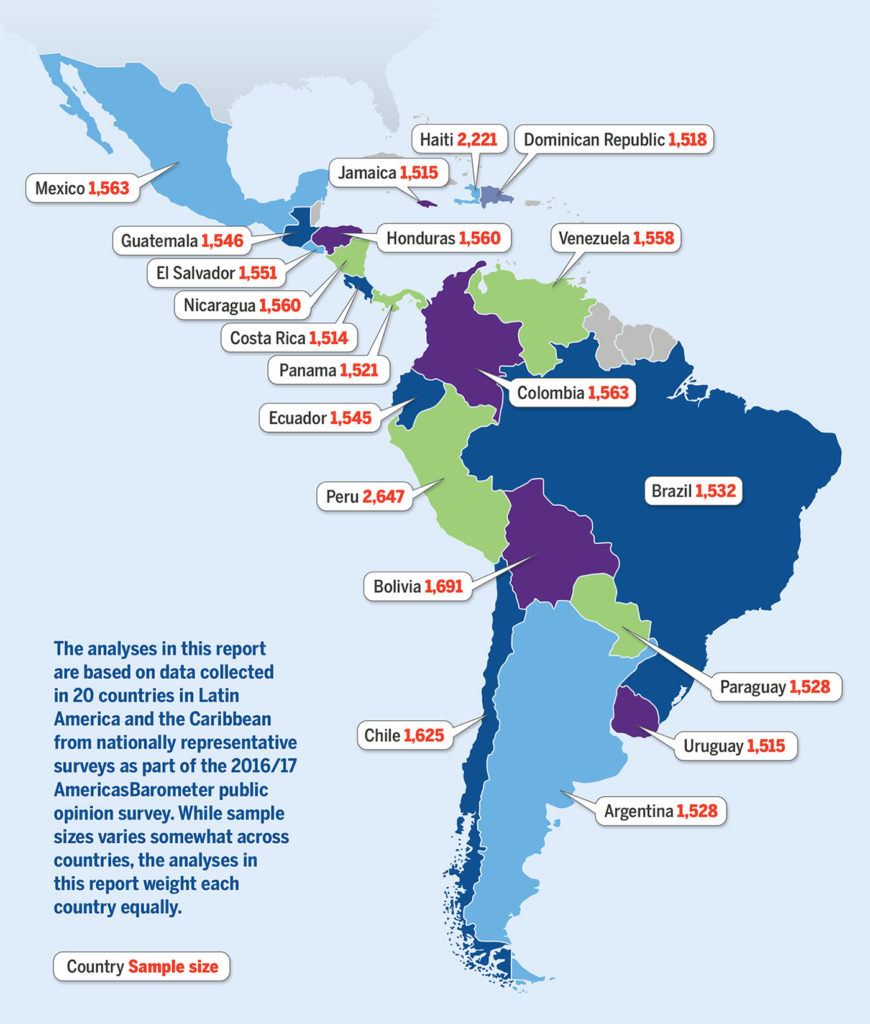
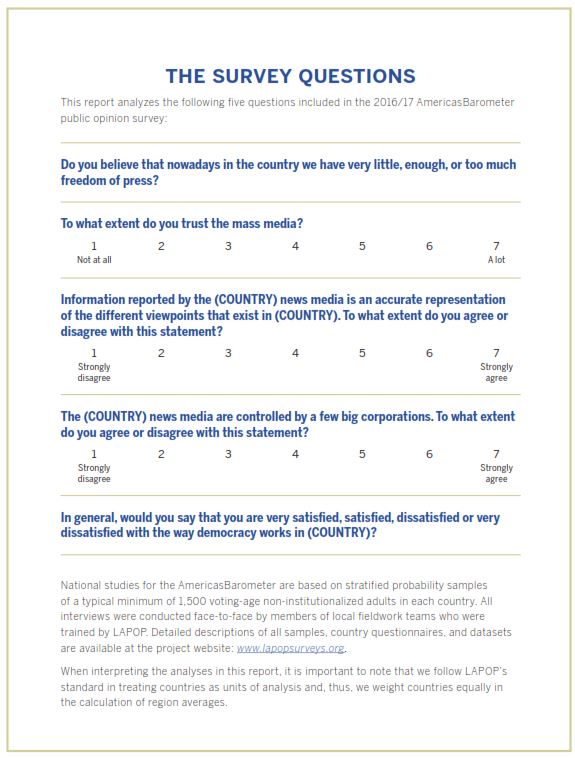
What Can the Data Tell Us? The Role of Public Opinion Data in Informing Policy and Advocacy
 Assessing the quality of any aspect of democratic governance is best done by taking into account multiple types of indicators. Aggregate or country-level indicators of electoral participation or expert ratings on corruption or political freedoms, for example, provide critical information for understanding the quality of a democracy. However, these types of indices do not directly gauge how the public experiences democracy in their daily lives. Citizens’ assessments of key institutions, such as the press and broader media environment, provide an important lens into how democracy functions in practice.
Assessing the quality of any aspect of democratic governance is best done by taking into account multiple types of indicators. Aggregate or country-level indicators of electoral participation or expert ratings on corruption or political freedoms, for example, provide critical information for understanding the quality of a democracy. However, these types of indices do not directly gauge how the public experiences democracy in their daily lives. Citizens’ assessments of key institutions, such as the press and broader media environment, provide an important lens into how democracy functions in practice.
Citizens’ perspectives on the media also matter because public opinion on key issues shapes public policy outcomes. This is because, in democracies, elections incentivize politicians to be responsive to citizens’ demands. In practice, elected officials’ policy agendas tend to reflect public opinion, particularly on salient issues.9 Where elites fall short of responding to public opinion, satisfaction with democracy tends to be lower.10 At the extreme, dissatisfaction with the political system and what it delivers can be destabilizing for democracy.11 Understanding the public’s experience with any aspect of democratic governance is essential for understanding the realities people face, anticipating citizens’ demands, and identifying actionable policy solutions.12
At the same time, it is not uncommon for the public to lack sophisticated understanding and knowledge of various aspects of democratic governance.13 As such, some differences between how experts rate the media environment and how citizens perceive or respond to it should be expected. Indeed, our research demonstrates that such a divergence exists in terms of perceptions of media ownership concentration in a sampling of countries in Latin America and the Caribbean. To the extent that public opinion studies can identify such gaps, they provide data that can serve as effective inputs into the design of issue awareness campaigns.
Gauging the public’s awareness of media pluralism and ownership concentration, and the ways these variables relate to satisfaction with democracy, is a necessary first step in identifying demand among the public for media reform. To the extent that the public perceives restrictions on media pluralism and expresses concern about concentration of ownership, advocacy groups may find it easier to build bridges with the public, and thus develop broader coalitions for reform.
Concerns about Press Freedom Are on the Rise in Latin America and the Caribbean
Across Latin America and the Caribbean there is a moderately high degree of concern about freedom of the press. In the average country in the region, nearly 50 percent of citizens believe there is “very little” press freedom in their country. Concerns about press freedom are high among those who are more socially marginalized; that is, on average, those who are poorer14 and less educated are more likely to perceive that there is very little freedom of the press.
The tendency to perceive a restricted environment with respect to freedom of the press is also greater among those who are less connected to the internet and who feel less capable of engaging in politics.15 Additionally, younger age cohorts tend to express the highest degree of concern regarding restrictions on freedom of the press.
However, there is significant variation by country. In Venezuela 67 percent of the population perceives there to be very little press freedom. These findings are not surprising considering that Freedom House has scored Venezuela’s level of press freedom as “not free” since 2002. In 2017 Venezuela became the second country in the region (joining Cuba) to be rated as “not free” by Freedom House. This downgrade was in large part a consequence of the deterioration of civil liberties, particularly those of political opponents and journalists. Following mass protests in 2017, a growing number of journalists have become the targets of frequent intimidation, violence, and detention by Venezuelan authorities.16
On the other extreme, Uruguay, Argentina, and Costa Rica are the countries with the smallest proportion of citizens (20 percent or less) who believe there is very little freedom of the press. This outcome also fits expectations, given that these are countries with established democracies and long-standing traditions of safeguarding freedom of expression as a key civil liberty. Indeed, Freedom House has consistently classified these countries as “free,” and in 2017 ranked them among the top 40 countries in the world with respect to freedom of the press.17
When it comes to assessments of press freedom, Freedom House (2017) expert ratings and the views of the mass public are in general alignment. The correlation between the percentage of citizens who perceive very little press freedom and expert scores on press freedom by Freedom House is moderately high (0.76, where 1.0 would be a perfect correlation). In other words, the experts and the public tend to agree on the state of press freedom in a given country.
Trust in the Media Is on the Decline
The quality of democracy depends not only on which citizens interact with an open and independent media, but also on the degree to which they can rely on media outlets as legitimate sources of information. Unfortunately, trust in the media in Latin America and the Caribbean has been on the decline. The proportion of respondents who report having high trust in the media dropped to its lowest level in 2016/17.18
As recently as 2004, nearly two-thirds of individuals reported having high trust in the media; however, now only half of the region’s citizens express a high level of trust in the media.19 Compared with prior years, this survey resulted in the largest proportion of respondents with low trust in the media, just under one-third.20
This decline in trust in the media coincides with Freedom House’s most recent report on a worldwide decline of freedom of the press in the last decade. It is likely that the forces undermining freedom of the press are taking their toll on public confidence in the media. Yet, at the same time, perceptions of deficits in freedom of the press do not appear to translate directly into low trust in the media. Rather, citizens do not always lose confidence in the media when outlets are restricted in their ability to supply news and information to the public, presumably because citizens do not always blame the media themselves for those restrictions.
As was the case for perceptions of freedom of the press, levels of trust in the media vary significantly by country. Nicaragua, the Dominican Republic, Paraguay, and Costa Rica top the rankings with over 60 percent of their citizens having high trust in the media. At the bottom of the figure, Colombia, Jamaica, and Haiti constitute the countries with the lowest proportion of citizens with confidence in the media (40 percent or less). The ranking of countries on trust in the media differs in some key respects from what is found for concerns about press freedom. For example, whereas Venezuela has the largest portion of the public that perceives very little freedom of the press, it appears in the middle of the comparative ranking on trust in the media.
Media Pluralism Is a Significant Concern for People in Latin America and the Caribbean
Concerns about freedom of the press and low levels of trust in the media in Latin America and the Caribbean are accompanied by concerns about a lack of media pluralism. On average, only one in two people feel that the media accurately represent different viewpoints that exist in their country.21
Individuals who do not typically surf the web and those who have minimal levels of political interest22 report perceiving the existence of media pluralism at higher rates than daily internet users and those who report caring a lot about politics. Put differently, those who access the internet more often and who are more engaged with politics are more cynical about the state of diversity in viewpoints in the media. However, the more an individual pays attention to the news, whether via TV, the radio, newspapers, or the internet,23 the more likely they are to perceive that the media accurately represent differing points of view.24
Once again, there are important differences in public opinion across countries. The percentage of those who believe media pluralism exists in their countries ranges from 65 percent in Nicaragua to 35 percent in Haiti. Mean views on media pluralism appear to be related to average levels of trust in the media across countries. Nicaragua tops the comparative ranking of countries on mean trust in the media, while Haiti scores toward the bottom.
It may be surprising to find Nicaragua in an elevated position in both rankings, given growing restrictions on press freedom in the country on the part of the ruling Sandinista National Liberation Front administration.25 The Varieties of Democracy (V-Dem) and Freedom House projects both classify Nicaragua among the countries in the region in 2016 and 2017 with the most restrictions on media plurality and freedom of the press.26 Yet, as noted already, citizens’ evaluations of the media do not always correspond to their evaluations of restrictions on the press.
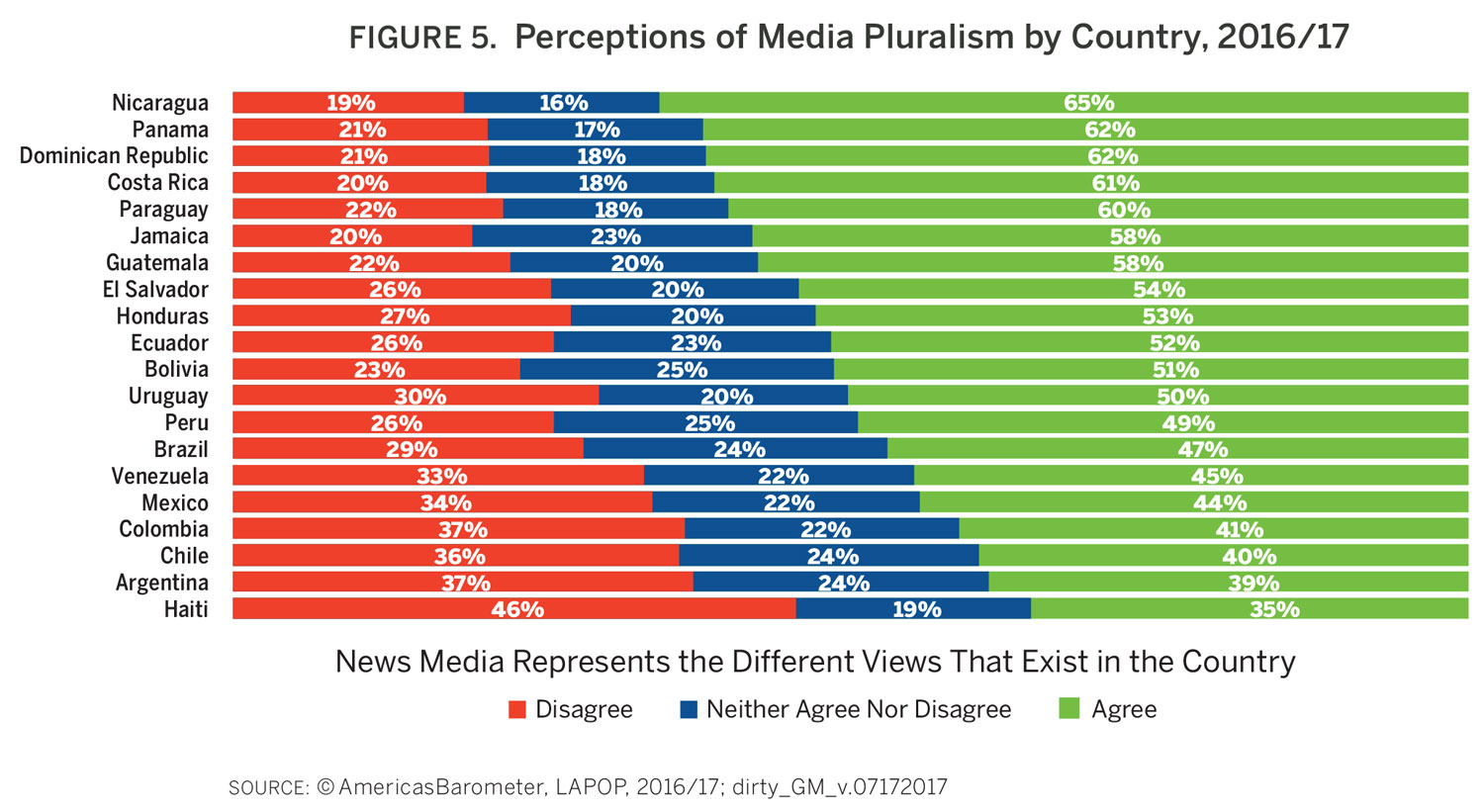 At least two dynamics could explain this lack of connection. First, it may be that the public does not hold the media responsible for a restricted media environment. Second, it may be that in a restricted media environment, citizens make extra effort to access alternate sources of information. Analyses not shown here indicate that at the individual level, those who consume more news are more likely to express greater trust in the media and (as noted above) to report that the media environment is sufficiently diverse to represent multiple points of view.
At least two dynamics could explain this lack of connection. First, it may be that the public does not hold the media responsible for a restricted media environment. Second, it may be that in a restricted media environment, citizens make extra effort to access alternate sources of information. Analyses not shown here indicate that at the individual level, those who consume more news are more likely to express greater trust in the media and (as noted above) to report that the media environment is sufficiently diverse to represent multiple points of view.
In short, citizens’ perceptions do not always align with expert assessments. Another example of this disconnect is provided by the case of Chile, which ranks at the bottom of the comparative chart on media pluralism and in the bottom half of country rankings with respect to trust in the media. However, both the V-Dem project and Freedom House rank Chile as having high levels of media pluralism and freedom of the press relative to the rest of the countries in the region.27
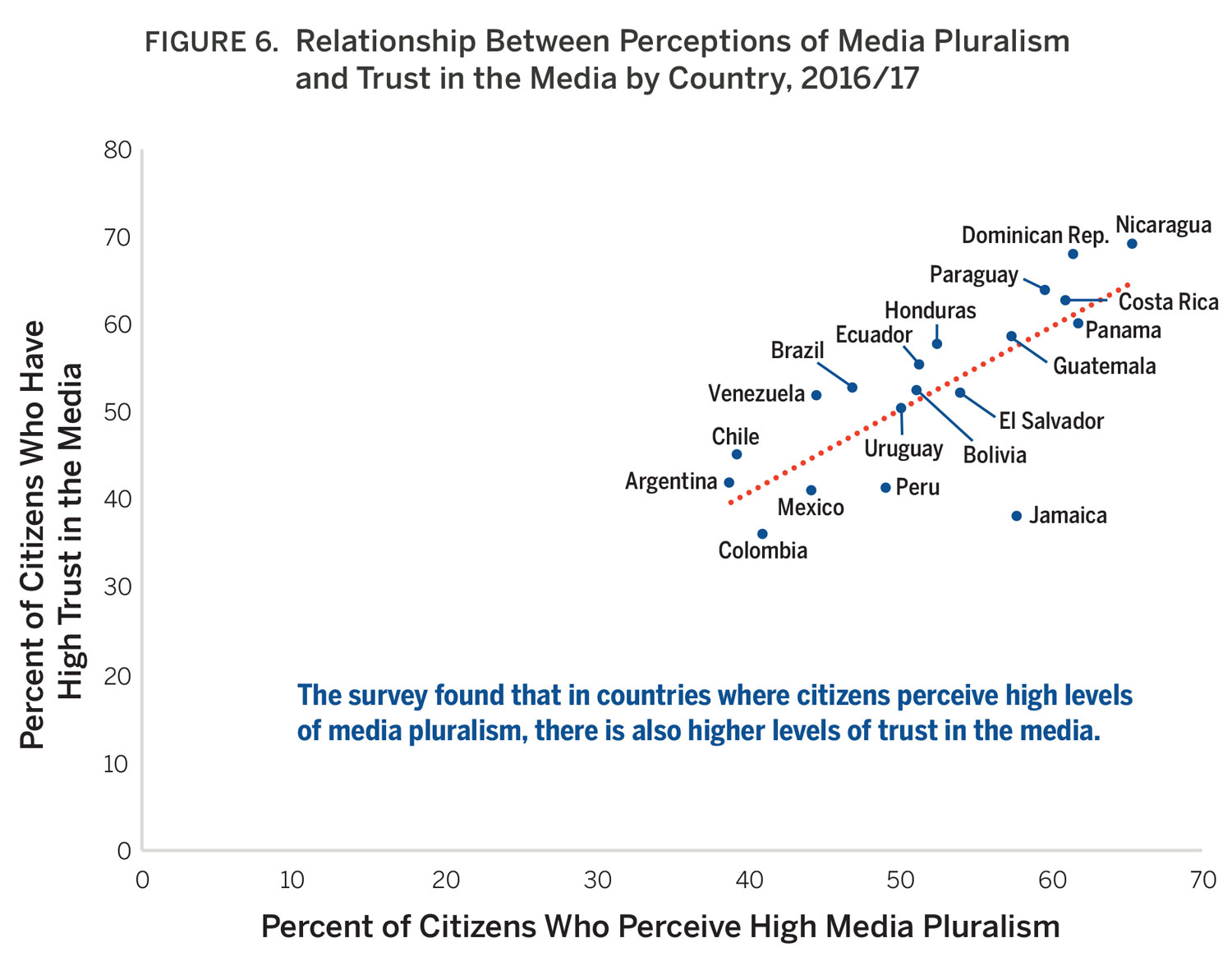 Overall, in an aggregate analysis, the public’s perceptions of media pluralism do not correspond in any significant way to expert ratings of media pluralism by the V-Dem project or to press freedom scores by Freedom House.28 The ordinary citizen’s interactions with the media— perhaps shaped by deliberate attempts to seek out alternate sources of information in more restricted environments—are different from those of experts. It is important to note that this lack of correspondence does not mean that the public fails to take stock of restrictions on freedom of the press; rather, the public does register elevated concerns about freedom of the press in the region that in some ways correspond to expert rankings.
Overall, in an aggregate analysis, the public’s perceptions of media pluralism do not correspond in any significant way to expert ratings of media pluralism by the V-Dem project or to press freedom scores by Freedom House.28 The ordinary citizen’s interactions with the media— perhaps shaped by deliberate attempts to seek out alternate sources of information in more restricted environments—are different from those of experts. It is important to note that this lack of correspondence does not mean that the public fails to take stock of restrictions on freedom of the press; rather, the public does register elevated concerns about freedom of the press in the region that in some ways correspond to expert rankings.
Further, it is important to note the clear correspondence among the public with respect to mean levels of trust in the media and perceptions of pluralism. Where the public sees more pluralism, it tends to be more trusting of the media. Nicaragua, the Dominican Republic, Paraguay, Costa Rica, and Panama form part of the top-ranking countries in both the percentage who perceive media pluralism and the proportion who have high trust in the media. Colombia, Haiti, and Mexico rank at the bottom in both measures. In fact, Nicaragua ranks first in both the percentage of citizens who report perceiving media pluralism in the country (65 percent) and the percentage of citizens with high levels of trust in the media (69 percent), while Haiti ranks at the bottom in the proportion who either perceive media pluralism (35 percent) or have high trust in the media (39 percent). Thus, there is a strong country-level correlation between country-average views of media pluralism and trust in the media (0.80, where 1.0 is perfect correlation).29
Public Concerns about Media Ownership Concentration Are High but Not Linked to Perceived Media Pluralism
Experts regard media pluralism as often very closely linked to media ownership: concentration of ownership limits media plurality by restricting media coverage in ways that prioritize the voice of those with political and economic power.30 With respect to the public, concerns about concentration of media ownership are elevated in Latin America and the Caribbean. In fact, concerns about media ownership are greater than public concerns about pluralism in the media. On average, nearly three out of five people in the region see the media as controlled by a few economic groups.31
At the individual level, higher education is strongly predictive of attitudes about concentration of media in the region. Higher education leads individuals to be more critical of their media environment when it comes to evaluating the types of groups that own or control media outlets. More frequent attention to the news and internet use, as well as higher degrees of political interest, predict higher rates of perceiving the media as being controlled by a few corporations.32
A cross-national comparison of views about media ownership concentration reveals important differences across the region, though these differences are not as pronounced as those observed for the distribution of views of media pluralism by country. That is, there is more consistency across countries in the percentage who believe media ownership concentration exists in their country than there is with respect to views about media pluralism.
In every country in the LAC region, at least half of the public sees the media in their country as captured by a few corporations. These views coincide with research on media ownership concentration, which characterizes the region as one in which the majority of media outlets, particularly print and broadcast, have been privately owned by a small share of powerful political and economic groups.33
Nonetheless, the data on public perceptions of ownership concentration offer some surprising findings. In Chile and Argentina, 61 percent of citizens in both countries agree that the media are controlled only by a few economic groups. These perceptions run counter to expert evaluations of levels of media ownership concentration in these countries. Though the region as a whole is consistently characterized as one with high media ownership concentration, Chile and Argentina are typically assessed as having comparatively lower degrees of ownership concentration than other countries in the region.34
A lack of cross-national data on media ownership concentration limits our ability to comprehensively assess the extent to which public opinion in Latin America and the Caribbean corresponds to expert ratings of media ownership concentration. However, an analysis in which we compare Noam’s35 calculations of the Herfindahl–Hirschman Index (HHI)36 for media concentration in Argentina, Brazil, Chile, and Mexico to public perceptions of media ownership concentration in those countries reveals a negative expert-citizen correlation (–0.55).37 This means that high rates of perceived media ownership concentration tend to be found among countries with lower levels of media ownership concentration, per HHI scores. As we found for media pluralism, here too public opinion does not fall in line with expert assessments, though some caution should be used in drawing strong conclusions regarding media concentration, given that the analysis could be conducted only for a small set of countries.
Surprisingly, high perceptions of media ownership concentration do not appear to undermine public perceptions of the media’s ability to accurately represent a plurality of views. There is no strong pattern of association between country averages on these media perception measures.38 In fact, a majority of citizens in many countries report that media pluralism and ownership concentration exist in their countries. This finding is less surprising if we recall that our analyses of expert-citizen correspondence reveal that public evaluations of media pluralism and ownership concentration do not correspond with expert evaluations of media environments in the region. While experts might hold that greater concentration of ownership inevitably erodes pluralism, the public frequently does not seem to perceive this.
One factor contributing to why the public does not make the same connection between high levels of media ownership and restrictions on media pluralism involves the public’s level of media sophistication. Many in the public lack the sort of extensive knowledge about the nature and scope of media ownership concentration that would enable their assessments to match expert scores. In comparison, it seems to be much easier for the general public to match expert evaluations of a country’s level of press freedom, an arguably more observable concept given the visibility of rhetorical, legal, and physical attacks on journalists to the public. Indeed, in a deeper analysis of the data, we found that the percentage of non-response or “do not know” answers to the question about evaluations of media ownership concentration (5.3 percent) is significantly higher than the proportion of non-response and “do not know” responses for evaluations of either media pluralism (2.9 percent) or press freedom (3.7 percent).39
As additional evidence that sophistication matters, we find that higher education is strongly predictive of attitudes about concentration of the media: more education leads individuals to be more critical of their media environment when it comes to evaluating the types of groups that own or control media outlets. More frequent attention to the news and internet use, as well as higher degrees of political interest and internal efficacy, also predicts higher rates of perceiving the media as being controlled by a few corporations.40 Internal efficacy is a particularly important explanatory variable: the belief that someone understands key political issues trumps the predicted effects of all other factors on the likelihood that a person believes news media in their country is owned only by a few corporations.41 Still, even the most educated, politically interested individuals with high degrees of media exposure do not make robust associations between their assessments of media ownership concentration and their views on media pluralism or press freedom.42
Media Pluralism and Trust Are Key for Democratic Governance in Latin America
The ways that citizens experience the media have important consequences for the quality of democracy. Perceptions of media pluralism and trust in the media are strongly linked to satisfaction with democracy.43 Citizens who perceive the media as accurately representative of different viewpoints or who have high trust in the media are far more likely to report being satisfied with the way democracy is functioning in their country. In fact, there is a 15–percentage point gap in satisfaction with democracy between those who believe media pluralism exists or trust in the media and those who do not think there is media pluralism in their country or have low trust in the media.44
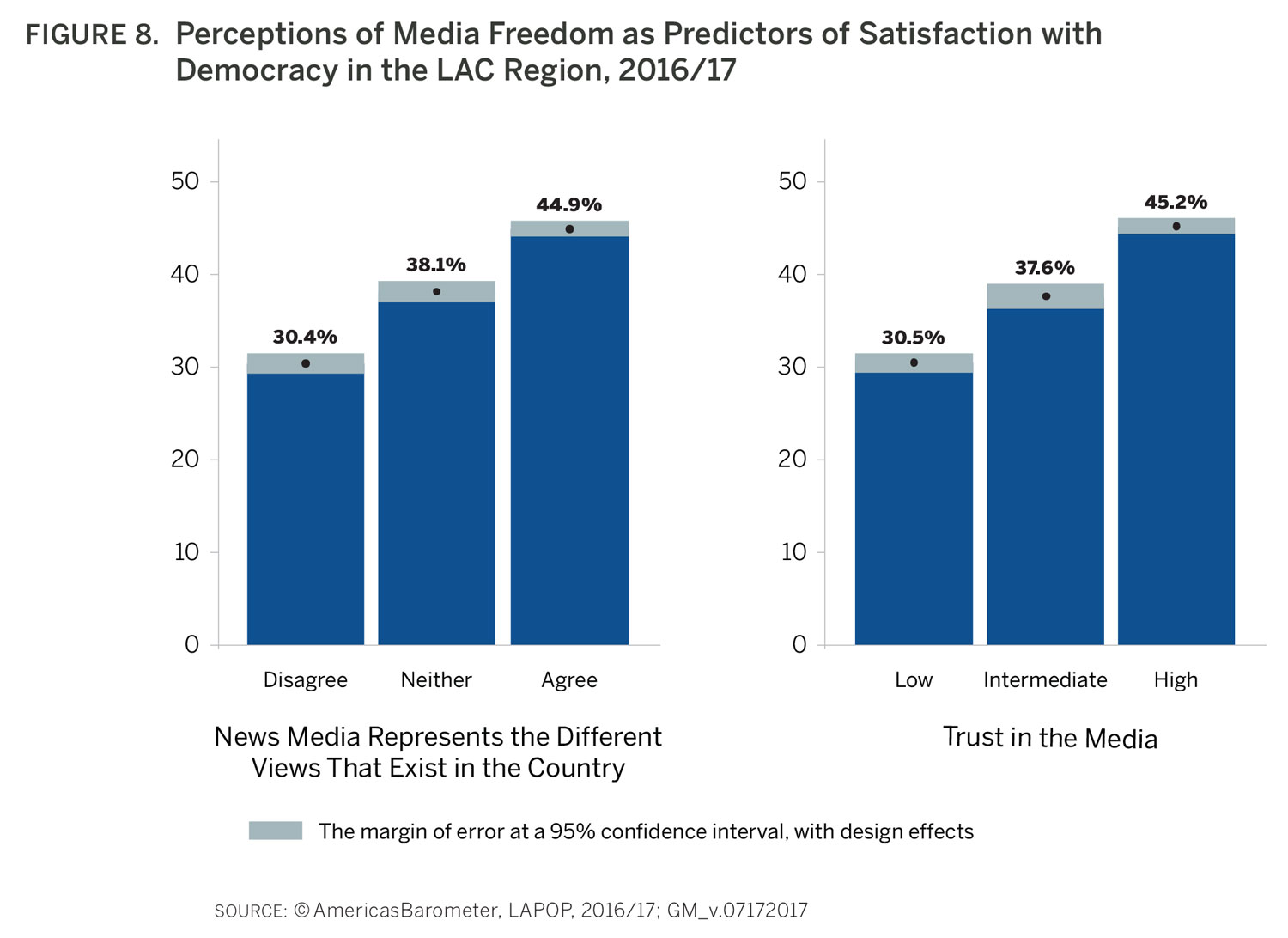 Earlier we reported a strong correlation between a country’s mean levels of trust in the media and views of media pluralism. In analyses not shown here, we also tested for and found evidence of this relationship at the individual level. While over 69 percent of those who perceive media pluralism in their country also have high trust in the media, only 27 percent of those who do not think the media in their country accurately represent a plurality of viewpoints have high trust in the media. Even when controlling for other individual-level characteristics, perceived media pluralism has the strongest relationship with trust in the media: the more citizens agree that media pluralism exists, the higher their reported trust in the media.45 As could be expected, high trust in the media is also more common among citizens who believe there is at least sufficient press freedom.
Earlier we reported a strong correlation between a country’s mean levels of trust in the media and views of media pluralism. In analyses not shown here, we also tested for and found evidence of this relationship at the individual level. While over 69 percent of those who perceive media pluralism in their country also have high trust in the media, only 27 percent of those who do not think the media in their country accurately represent a plurality of viewpoints have high trust in the media. Even when controlling for other individual-level characteristics, perceived media pluralism has the strongest relationship with trust in the media: the more citizens agree that media pluralism exists, the higher their reported trust in the media.45 As could be expected, high trust in the media is also more common among citizens who believe there is at least sufficient press freedom.
The ways the public experiences the media are fundamental to citizens’ assessments of the quality of democracy in the region. In countries where the media do not accurately represent a plurality of views, citizens are impeded in their efforts to access the media and the media are not able to fulfill their role as an institution that facilitates the distribution of information necessary to understand a country’s sociopolitical environment and hold elected officials accountable. In such contexts, the media risk losing their legitimacy as a resource that citizens can base their political preferences and actions on in efforts to hold their leaders accountable. If citizens are not able to rely on the media in this manner and do not believe that the media environment in their country is sufficiently open, their attitudes about the legitimacy of a democratic system are also likely to suffer.
From Polling to Practice: Recommendations for Media Reform in Latin America and the Caribbean
The belief that democracy is the best form of government appears to be losing its appeal in Latin America and the Caribbean.46 Indeed, nearly three decades after the region’s wave of democratization in the 1980s, faith in many societal institutions—including the media—is faltering. Moreover, the crisis of democracy in the region parallels growing concerns about diminishing press freedom and declining levels of trust in media.
While the current situation is far from ideal, the findings from our analyses point to the broader conclusion that focusing efforts on strengthening media ecosystems can help to address and, ideally, counter the region’s growing dissatisfaction with democracy. This is because where citizens have more confidence in the media and feel they have access to pluralistic media, they are also more satisfied with democracy.
Perhaps one of the most important contributions of this report and its underlying research is that it represents the first effort to analyze public perceptions of media ownership concentration in Latin America and the Caribbean. One revealing finding is that public perceptions of media concentration do not always align with expert analysis of the situation in many countries. Moreover, the public at large does not connect media ownership concentration to diminished media plurality. These gaps between expert assessments and the public’s beliefs are important to identify, as they might prove a challenge to long-term reform efforts. As examples from Latin America have shown, the most successful media reform efforts have depended on broad, multistakeholder coalitions.47 Deficits in public awareness of the important dynamics underlying these crucial topics may pose an impediment to such reform endeavors in the future.
While the challenges to media environments in Latin America and the Caribbean are many, the results of our analysis of the AmericasBarometer 2016/17 survey suggest four areas where media reform advocates should target their efforts:
■ Focus on initiatives that promote media content diversity and citizen access to a wider range of media outlets in order to generate greater trust in the media and quality democratic governance. Democratic legitimacy is closely intertwined with perceptions of media pluralism and trust in the media. Citizens who perceive that the media accurately represent a plurality of views have higher trust in the media and are consequently more satisfied with the way democracy is functioning in their country. The most recent AmericasBarometer regional report finds that citizens in the region have increasingly negative views of democracy. This decay in support for democracy and its core institutions and processes may be, at least in part, linked to a decline in citizens’ perceptions of press freedom and trust in the media, as well as a deterioration in public spaces for dialogue.
■ Invest in media literacy projects that can educate the public on the nature and consequences of media ownership concentration. Public opinion on media pluralism and ownership concentration do not correspond in any significant way with expert evaluations of media environments in the region. Moreover, for citizens in Latin America and the Caribbean it is not a given that media ownership concentration and media pluralism are opposing forces. The public’s ability to demand greater leader accountability and better governance with respect to the quality of the media environment in their country would be enhanced by understanding the detrimental consequences of restrictions to media independence and openness.
■ Support initiatives and organizations that seek legal reforms in favor of more independent and transparent media market systems and regulations. Media ownership de-concentration can facilitate the formation of new media outlets and greater circulation of high-quality and balanced information. The quality of democracy is contingent on a diversely informed public that can access the information necessary to monitor, react to, and influence decisions made by political leaders.
■ Invest in public opinion and audience research to further understand the public’s experience with the media environment. Given the important consequences that citizens’ evaluations of the media have for their assessments of the quality of democracy, research efforts focused on measuring the nature of media environments would be advanced by continuing to make strides in complementing expert assessments with data on how restricted or open the public perceive the media to be. Furthermore, there is a relative dearth of reliable information on which media platforms citizens currently use to access news. Without data on how people perceive the media and which media outlets people are actually paying attention to, it is more difficult to develop sound policy. In short, more data are needed to develop better advocacy and policy responses.
Latin America and the Caribbean have been home to some of the most innovative and successful media reform efforts of late. While the region as a whole now faces an increasingly challenging environment for both media and democracy writ large, it is our hope that the information assembled in this report can be used to engender strategic action that bolsters pluralistic media environments that strengthen democracy.
Appendix
We employ logit regression models in Appendices 1–3, 5, and 7. All variables in the models are recoded 0–1 and the models control for country fixed effects.
Acknowledgements
Cover Photo Credit: Nicolas Nova, CC BY 2.0 DEED.
Footnotes
- Timothy Besley and Robin Burgess, “Political Agency, Government Responsiveness and the Role of the Media,” European Economic Review 45, nos. 4–6 (2001): 629–640.
Shanto Iyengar and Donald R. Kinder, News That Matters: Television and American Opinion (Chicago: The University of Chicago Press, 1987).
- The analyses in this report focus on countries from the Latin American and Caribbean region and exclude the United States and Canada, with the exception of some cross-country analyses. When referring to data and analyses, the LAC region in this report consists of Argentina, Bolivia, Brazil, Chile, Colombia, Costa Rica, the Dominican Republic, Ecuador, El Salvador, Guatemala, Haiti, Honduras, Jamaica, Mexico, Nicaragua, Panama, Paraguay, Peru, Uruguay, and Venezuela.
- Carolina Matos, Media and Politics in Latin America: Globalization, Democracy and Identity (New York: I.B Tauris, 2012).
- María Soledad Segura and Silvio Waisbord, Media Movements: Civil Society and Media Policy Reform in Latin America (London: Zed Books, 2016), 15–16.
- Don Podesta, Media in Latin America: A Path Forward, Center for International Media Assistance (Washington, D.C.: National Endowment for Democracy, 2016), http://www.cima.ned.org/wp-content/ uploads/2016/01/CIMA-Media-in-Latin-America_the-Path-Forward.pdf.
- Segura and Waisbord, Media Movements: Civil Society and Media Policy Reform in Latin America.
Christof Mauersberger, Advocacy Coalitions and Democratizing Media Reforms in Latin America: Whose Voice Gets on the Air? (Springer International Publishing, 2015).
- Segura and Waisbord, Media Movements: Civil Society and Media Policy Reform in Latin America, 15–16.
- J. Adams, M. Clark, L. Ezrow, and G. Glasgow, “Understanding Change and Stability in Party Ideologies: Do Parties Respond to Public Opinion or to Past Election Results?” British Journal of Political Science 34, no. 4 (2004): 589–610.
Stuart N. Soroka and Christopher Wlezien, Degrees of Democracy: Politics, Public Opinion, and Policy (New York: Cambridge University Press, 2010).
- Paul Burstein, “The Impact of Public Opinion on Public Policy: A Review and an Agenda,” Political Research Quarterly 56, no. 1 (2003): 29–40.
Benjamin I. Page and Robert Y. Shapiro, The Rational Public: Fifty Years of Trends in Americans’ Policy Preferences (Chicago: University of Chicago Press, 2010).
- Stefanie Reher, “The Effects of Congruence in Policy Priorities on Satisfaction with Democracy,” Journal of Elections, Public Opinion and Parties 26, no. 1 (2015): 40–57.
- Mitchell A.Seligson and John A. Booth, “Special Report on Honduras: Predicting Coups? Democratic Vulnerabilities, The AmericasBarometer and the 2009 Honduras Crisis,” AmericasBarometer Insights No. 821 (Nashville, Tennessee: Latin American Public Opinion Project, Vanderbilt University, 2009).
- Elizabeth J. Zechmeister, “Chapter 1. The Supply of Basic Liberties in the Americas,” in The Political Culture of Democracy in the Americas, 2016/17: A Comparative Study of Democracy and Governance, Eds. Mollie J. Cohen, Noam Lupu, and Elizabeth J. Zechmeister (Nashville, Tennessee: Latin American Public Opinion Project, Vanderbilt University, 2017).
- Michael X. Delli Carpini and Scott Keeter, “Measuring Political Knowledge: Putting First Things First,” American Journal of Political Science 37, no. 4 (1993): 1179–1206.
- LAPOP measures wealth using responses to a module about ownership of goods. It includes questions about ownership of these items: TV, refrigerator, landline telephone, cell phone, cars, washing machine, microwave oven, motorcycle, potable water, indoor bathroom, computer, flat panel TV, internet, and connection to the sewage system. From these variables, LAPOP uses factor analysis to calculate an index of wealth. We refer to those who are “wealthier” or in “higher wealth categories” as those who own a greater number of consumer goods in comparison with those less wealthy or in lower wealth categories who own a smaller number of consumer goods.
- Internet use and internal political efficacy are measured using the following survey items from the AmericasBarometer:
WWW1. Talking about other things, how often do you use the internet? (1) Daily (2) A few times a week (3) A few times a month (4) Rarely (5) Never
EFF2. You feel that you understand the most important political issues of this country. How much do you agree or disagree with this statement? Scale 1 (Strongly disagree) – 7 (Strongly agree)
- See Freedom House, “Venezuela Sheds Its Democratic Façade,” February 6, 2017, https://freedomhouse.org/blog/venezuela-sheds-itsdemocratic-fa-ade; Freedom House, “Venezuela Profile,” 2017, https:// freedomhouse.org/report/freedom-world/2017/venezuela; Committee to Protect Journalists, “Journalists Covering Venezuela Protests Harassed, Attacked, and News Websites Blocked,” April 12, 2017, https://cpj. org/2017/04/journalists-covering-venezuela-protests-harassed-a.php
- See Freedom House, “Populists and Autocrats: The Dual Threat to Global Democracy,” https://freedomhouse.org/report/freedom-world/freedomworld-2017.
- Original responses on a 1–7 scale are recoded into three categories: Low trust (1/3), Intermediate trust (4), and High trust (5/7). Results from the 2014 AmericasBarometer are not included because this survey question was not asked as part of the core questionnaire in that round.
- The pattern of results across time for the region is similar if the sample is restricted to only those countries included in the 2004 wave of the AmericasBarometer, though the decrease in 2016/17 is not as steep.
- These differences are statistically significant at a 95 percent confidence level.
- Original responses on a 1–7 scale are recoded into three categories: Disagree (1/3), Neither agree nor disagree (4), and Agree (5/7).
- Measured using the following survey item from the AmericasBarometer:
POL1. How much interest do you have in politics: a lot, some, little, or none?
- Measured using the following survey items from the AmericasBarometer:
GI0. About how often do you pay attention to the news, whether on TV, the radio, newspapers, or the internet? (1) Daily (2) A few times a week (3) A few times a month (4) Rarely (5) Never
- These relationships hold when controlling for demographic and socioeconomic characteristics, as well as measures of media exposure and political awareness. See regression results in the Appendix.
- See Freedom House, “Nicaragua,” https://freedomhouse.org/report/ freedom-press/2016/nicaragua.
- The Varieties of Democracy project gives Nicaragua a mean score of 1.75 on its 0–3 scale of media perspective, where 0 means the major media represent only the government’s perspective and 3 that all perspectives that are important in this society are represented in at least one of the major media outlets. Freedom House classifies Nicaragua as “partly free” with a score of 55 on its Freedom of the Press scale that ranges from 0 (Free) to 100 (Not free).
- The Varieties of Democracy project gives both Chile and the United States a mean score of 2.4 on its 0–3 scale of media perspectives. Freedom House gives Chile a score of 29 and the United States a 23 on its Freedom of the Press scale.
- See Appendix 4. The correlation between the proportion of citizens who perceive media pluralism in each country and V-Dem scores is –0.19, while the correlation with Freedom House freedom of the press scores is –.05.
- The individual level correlation between these two measures is robust at 0.38.
- Taylor Boas, “Mass Media and Politics in Latin America,” in Constructing Democratic Governance in Latin America, 4th ed., edited by Jorge I. Domínguez and Michael Shifter (Baltimore: Johns Hopkins University Press, 2012).
- Original responses on a 1–7 scale are recoded into three categories: Disagree (1/3), Neither agree nor disagree (4), and Agree (5/7).
- These relationships hold when controlling for demographic and socioeconomic characteristics, as well as measures of media exposure and political awareness. See regression results in the Appendix.
- Boas, “Mass Media and Politics in Latin America.”
- Eli M. Noam and The International Media Concentration Collaboration, Who Owns the World’s Media? Media Concentration and Ownership around the World (Oxford: Oxford University Press, 2016).
- Noam and The International Media Concentration Collaboration, Who Owns the World’s Media?
- The HHI is a measure of media ownership concentration based on the media revenue shares by competing firms in the media market. Noam calculates this index with the most recent data available for daily newspapers, magazines, radio, broadcast TV, non-broadcast TV (cable and satellite), and online news for 30 countries worldwide. The index is weighted by attention, which Noam defines as “the average time spent by an average user in that country with that medium, pro-rated to the share of that medium’s news content in its overall content, and also adjusting for the penetration of that medium in a country’s population” (2016, p. 1272). The index ranges from 0–10,000, where an HHI under 1,500 is defined as not concentrated, a score between 1,500–2,500 is considered moderate concentration, and anything above 2,500 is considered concentration.
- See Appendix 6.
- The individual-level correlation for these measures is 0.14.
- The differences in the proportion of non-response and “do not know” answers between evaluations of media pluralism and press freedom are also significantly different from one another. These differences are statistically significant at a 95 percent confidence level.
- These relationships hold when controlling for demographic and socioeconomic characteristics, as well as measures of media exposure and political awareness. See regression results in the Appendix.
- Individual country analyses show that the positive correlation between internal efficacy and perceptions of media ownership concentration holds for every country in the LAC region.
- Correlations between evaluations of media ownership and media pluralism or press freedom for these types of individuals do not exceed 0.13.
- We employ a logit regression model that controls for demographic and socioeconomic characteristics, as well as internal efficacy, political interest, and executive job approval. See regression results in the Appendix.
- Similarly, citizens in the LAC region who believe there is at least sufficient press freedom are more likely to be satisfied with democracy than those who think press freedom is restricted in their country. The predicted effects of perceptions of media pluralism, evaluations of press freedom, and trust in the media on satisfaction with democracy hold when controlling for these same individual characteristics.
- Individual country analyses show that the positive correlation between perceptions of media pluralism and trust in the media hold for every country in the LAC region.
- Cohen, Lupu, and Zechmeister, The Political Culture of Democracy in the Americas, 2016/17.
- Segura and Waisbord, Media Movements: Civil Society and Media Policy Reform in Latin America.

